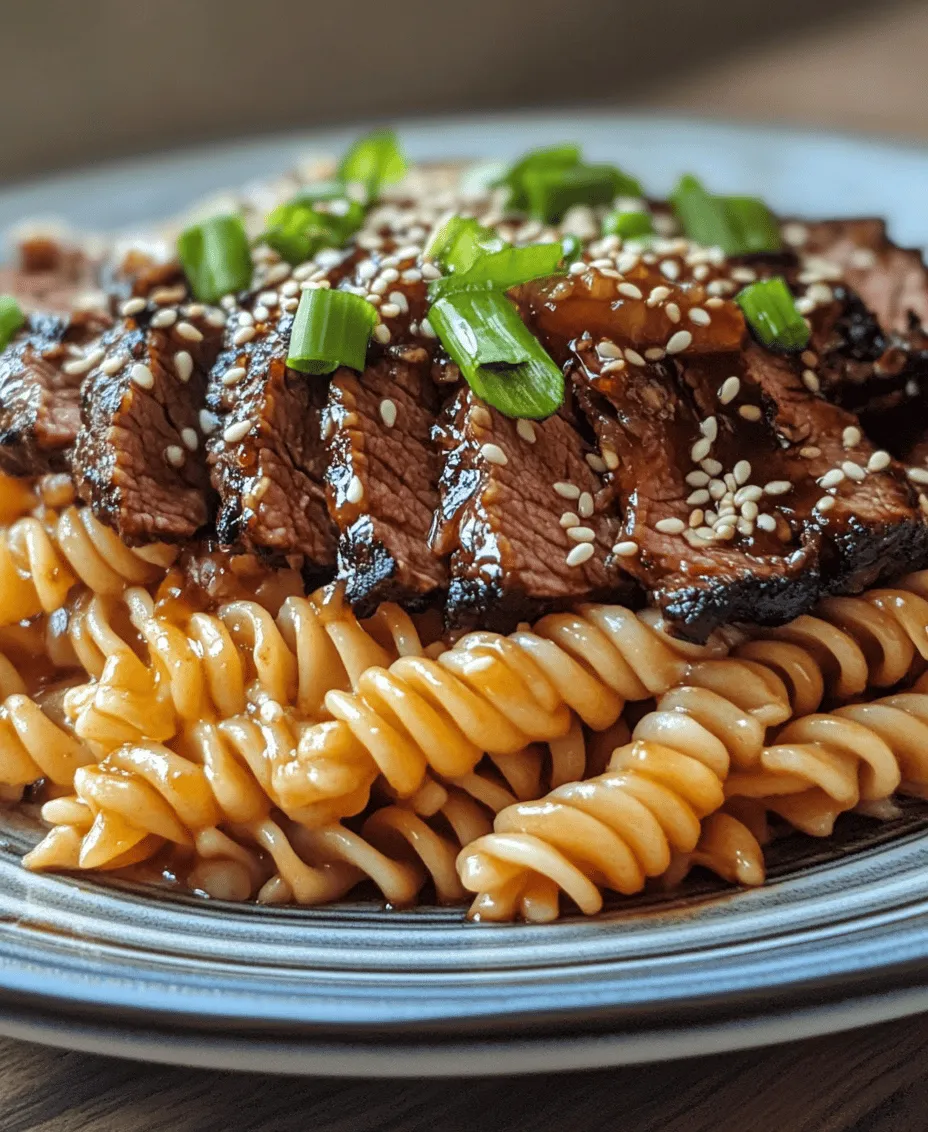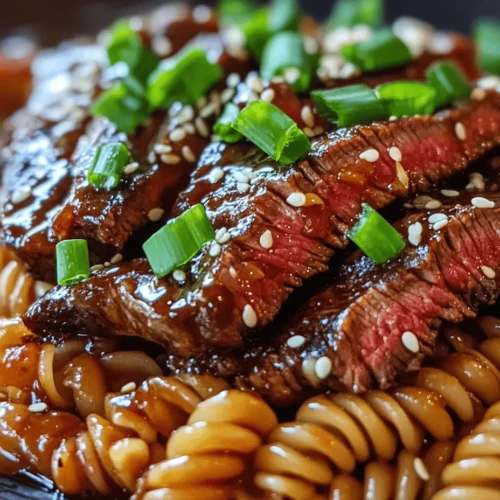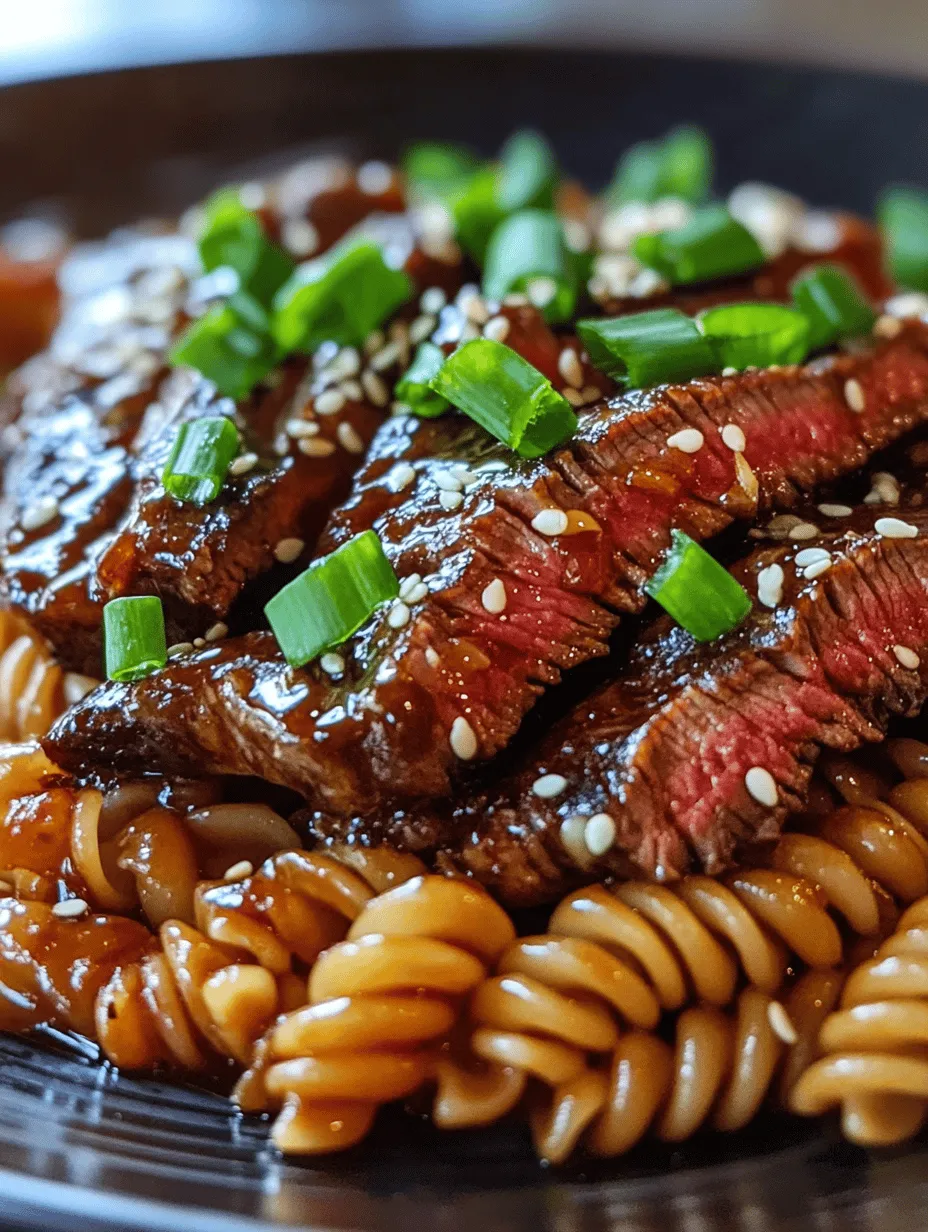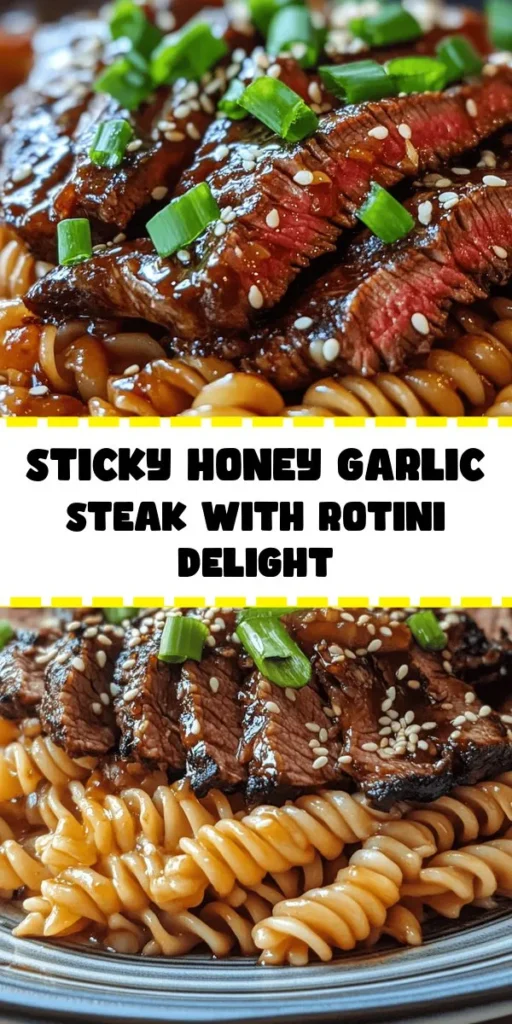Introduction
Welcome to a culinary adventure that combines the rich, savory flavors of steak with the comforting texture of pasta! In this article, we’ll be exploring the delightful recipe for Sticky Honey Garlic Steak and Rotini—a dish that promises to tantalize your taste buds and leave you craving more. This unique combination of ingredients not only brings together two beloved staples but also enhances your dining experience through a perfect balance of flavors.
The appeal of combining steak and pasta lies in their contrasting yet complementary textures. The tender, juicy flank steak pairs beautifully with the spiraled rotini, which captures the sauce and adds a satisfying bite to every mouthful. This dish is a celebration of flavor, where succulent meat meets the heartiness of pasta, creating a fulfilling meal that works for weeknight dinners or special occasions alike.
In cooking, achieving a harmonious balance of flavors is paramount. The sweetness of honey, the zing of garlic, and the umami richness of soy sauce come together to create a sauce that envelops the steak and pasta in a delightful glaze. This recipe is not just about cooking; it’s about crafting a flavor experience that showcases the art of balance and harmony in food preparation.
As you read through this article, you can expect to find a comprehensive guide that covers everything from understanding the essential ingredients to step-by-step cooking instructions. We’ll dive into the importance of marinating the flank steak, the ideal cooking techniques for achieving perfectly al dente rotini, and tips for ensuring that each component of the dish shines through. Let’s embark on this flavorful journey and discover how to prepare Sticky Honey Garlic Steak and Rotini!
Understanding the Ingredients
To create a dish as delicious as Sticky Honey Garlic Steak and Rotini, it’s essential to understand the role of each ingredient in the recipe. This awareness not only enhances your cooking skills but also allows you to appreciate the flavors and textures that come together on your plate.
Flank Steak: Characteristics and Why It’s Chosen
Flank steak is the star of this dish, and for good reason. Known for its robust flavor and relatively lean profile, flank steak is a cut of beef that comes from the abdominal muscles of the cow. Its fine grain and fibrous texture make it ideal for marinating, as it absorbs flavors beautifully. When cooked properly, flank steak becomes tender and juicy, offering a satisfying chew that pairs wonderfully with pasta.
Choosing flank steak for this recipe also allows for versatility; it can be grilled, pan-seared, or broiled, making it an excellent choice for different cooking methods. Its natural flavor enhances the sticky honey garlic sauce, creating a mouthwatering experience that’s sure to impress.
Rotini Pasta: Texture and How It Complements the Dish
Next up is rotini pasta, a corkscrew-shaped noodle that is not only visually appealing but also practical for this dish. The unique shape of rotini allows it to hold onto sauces exceptionally well, making each bite flavorful. Its texture provides a delightful contrast to the tender steak, ensuring that every forkful is a harmonious blend of sensations.
When selecting pasta for this recipe, rotini is an ideal choice because it captures the sticky honey garlic sauce, allowing the sweet and savory flavors to envelop the pasta perfectly. This creates an enjoyable eating experience where the ingredients work in unison, enhancing the overall flavor profile.
The Role of Honey in Cooking
Honey plays a pivotal role in this recipe, contributing both sweetness and a beautiful glaze to the steak. As a natural sweetener, honey not only adds flavor but also aids in caramelization during cooking, creating a rich, sticky coating that elevates the dish. Its complex flavor profile, which can range from floral to earthy, adds depth to the sauce, making it irresistible.
In addition to its flavor, honey also acts as a tenderizer due to its acidity. This helps to break down the proteins in the flank steak, resulting in a more tender final product. The balance of sweetness from the honey against the savory notes of garlic and soy sauce creates a delicious contrast that’s pivotal to the dish’s success.
Sweetness and Glaze Properties
The sweetness of honey is accentuated by the savory elements of the dish, allowing for a glaze that coats the steak and pasta beautifully. As the honey cooks, it thickens and caramelizes, creating a luscious sauce that clings to the ingredients. This sticky texture not only enhances the visual appeal but also invites diners to savor every bite.
The Significance of Garlic and Soy Sauce
Garlic is another key player in this recipe, providing aromatic depth and a savory kick that complements the sweetness of honey. It’s known for its robust flavor and health benefits, making it a staple in many cuisines worldwide. When combined with honey and soy sauce, garlic adds a savory richness that elevates the entire dish.
Soy sauce, on the other hand, contributes umami—one of the five basic tastes that enhances the overall flavor experience. Its salty, savory profile balances the sweetness of honey and the aromatic garlic, creating a well-rounded sauce that brings all the elements of the dish together. The combination of these ingredients ensures that the sticky sauce is not just sweet but layered with complex flavors that delight the palate.
Apple Cider Vinegar: Its Role in Balancing Flavors
To achieve the perfect balance in flavors, apple cider vinegar is introduced into the marinade. This ingredient adds acidity, which is crucial for cutting through the richness of the steak and balancing the sweetness of honey. The vinegar enhances the overall flavor profile, providing a brightness that elevates the dish.
In addition to its flavor-enhancing properties, apple cider vinegar also has health benefits, including aiding digestion and providing antioxidants. Its inclusion in the marinade not only serves a culinary purpose but also adds a touch of wellness to the meal.
Cornstarch: Thickening Agent and Texture Enhancer
Cornstarch plays an important role in this recipe by acting as a thickening agent. When mixed with the marinade, it helps create a glossy, thick sauce that clings to the steak and pasta beautifully. This ensures that each bite is packed with flavor and that the sauce doesn’t run off the plate.
The thickening properties of cornstarch also contribute to the overall texture of the dish. It provides a satisfying mouthfeel, enhancing the dining experience and making the sauce feel luxurious and indulgent.
Vegetable Oil: Cooking Method and Its Impact
Finally, vegetable oil is used in the cooking process, particularly for searing the flank steak. The choice of oil is important, as it has a high smoke point and allows for effective heat transfer, ensuring that the steak develops a beautiful sear without burning. This step is crucial for achieving the right texture and flavor in the steak, providing a contrast to the tenderness of the rotini.
Using vegetable oil also allows for a neutral flavor, ensuring that the focus remains on the star ingredients of honey, garlic, and soy sauce. This thoughtful choice is essential in creating a well-balanced dish that highlights the best of each component.
Marinating the Flank Steak
Now that we understand the importance of each ingredient, let’s delve into the marination process of the flank steak. Marinating is a crucial step in enhancing the flavor and tenderness of the meat, allowing the spices and ingredients to penetrate deeply.
Importance of Marinating
Marinating not only infuses the steak with flavor but also helps to tenderize the meat. The acidity in the marinade, provided by ingredients like apple cider vinegar and honey, breaks down the protein fibers, resulting in a more tender bite. This process is essential for tougher cuts of meat, such as flank steak, which can benefit significantly from a good marinade.
How Flavors Penetrate the Meat
When marinating, it’s essential to allow enough time for the flavors to penetrate the meat fully. The longer the steak sits in the marinade, the more flavorful it becomes. However, it’s important to find the right balance; over-marinating can lead to a mushy texture. For flank steak, a marination time of 30 minutes to 2 hours is generally ideal.
The Science Behind Marination Times
The science behind marination lies in the interaction between the meat and the marinade. As the steak sits in the mixture, the acids and enzymes begin to break down the proteins, allowing the flavors to infuse. Typically, less time is needed for more acidic marinades, while a longer duration is suitable for less acidic options.
Step-by-Step Process of Creating the Marinade
To create the marinade for Sticky Honey Garlic Steak, follow these simple steps:
1. Gather Ingredients: In a mixing bowl, combine 1/4 cup of honey, 1/4 cup of soy sauce, 3 minced garlic cloves, 2 tablespoons of apple cider vinegar, and 1 tablespoon of cornstarch.
2. Mix Well: Whisk the ingredients together until the cornstarch is fully dissolved and the mixture is smooth.
3. Prepare Flank Steak: Place the flank steak in a resealable plastic bag or a shallow dish.
4. Add Marinade: Pour the marinade over the steak, ensuring it is evenly coated.
5. Seal and Refrigerate: If using a bag, seal it tightly, removing as much air as possible. If using a dish, cover it with plastic wrap. Refrigerate for 30 minutes to 2 hours, allowing the flavors to meld.
Tips for Ensuring Even Marination
To ensure that the steak marinates evenly, it’s important to occasionally turn the steak in the marinade, especially if using a dish. This promotes even exposure to the marinade, ensuring that every part of the meat is infused with flavor.
Best Practices for Covering and Refrigerating
Always remember to cover the steak while it marinates to prevent any cross-contamination with other foods in the refrigerator. Using a resealable bag is often convenient, as it minimizes cleanup and allows for easy flipping of the meat to ensure an even marinade.
Cooking the Rotini Pasta
While the flank steak is marinating, it’s time to prepare the rotini pasta. Cooking pasta may seem straightforward, but there are nuances to achieving the perfect texture that complements the steak and sauce.
Selecting the Right Pasta
Rotini is the pasta of choice for this dish, but selecting the right type of rotini is important. Look for high-quality pasta made from durum wheat, which provides the best texture and flavor. Whole grain or gluten-free options are also available for those with dietary restrictions.
Why Rotini is a Great Choice for This Dish
Rotini’s spiral shape is not only visually appealing but also practical. The ridges of the pasta help to capture the sticky honey garlic sauce, ensuring that every bite is flavorful. This makes it an excellent match for the dish, as it provides a satisfying texture that pairs beautifully with the tender flank steak.
Cooking Techniques for Perfect Pasta
To cook rotini pasta perfectly, follow these key techniques:
1. Use Plenty of Water: Fill a large pot with water, allowing for enough space for the pasta to move freely. A general rule of thumb is to use about 4 to 6 quarts of water for every pound of pasta.
2. Salt the Water: Adding salt to the boiling water is crucial for flavor. Use about 1 to 2 tablespoons of salt per gallon of water. This enhances the pasta’s taste and ensures it is seasoned from the inside out.
3. Bring to a Rolling Boil: Wait until the water reaches a rolling boil before adding the pasta. This ensures that the pasta cooks evenly.
Importance of Salted Water and Timing
Cooking pasta in salted water enhances its flavor significantly. The timing is also critical; follow the package instructions for cooking time, but start checking for doneness a minute or two earlier. Rotini typically cooks in about 8-10 minutes, but you’ll want to aim for al dente—firm to the bite but not hard.
Tips for Achieving Al Dente Texture
To achieve that perfect al dente texture, taste the pasta a minute or two before the suggested cooking time is up. It should be tender but still have a slight bite to it.
How to Know When It’s Done
To check for doneness, take a piece of rotini out of the pot and bite into it. If it has a slight firmness in the center, it’s ready to be drained. Remember that the pasta will continue to cook slightly after being drained, so it’s best to err on the side of slightly undercooked.
Draining and Setting Aside: Why This Step Matters
Once the pasta is cooked to perfection, drain it in a colander but do not rinse it. Rinsing removes the starch that helps the sauce adhere to the pasta. Instead, toss the drained rotini with a small drizzle of olive oil to prevent sticking and keep it moist while you finish preparing the steak and sauce.
This preparation will set you up for a delicious meal, where the sticky honey garlic sauce will cling perfectly to both the steak and the rotini, ensuring a delightful dining experience.
Stay tuned as we continue to explore the cooking process for the steak and the final assembly of this mouthwatering dish!

Searing the Flank Steak
Searing steak is an essential technique that not only enhances the flavor but also creates a beautiful crust that elevates your dish. To achieve the perfect sear, it’s important to start with a well-prepared flank steak. Pat the steak dry with paper towels to remove any excess moisture, which will help you achieve that coveted golden-brown crust.
The Art of Searing
When you place the steak in a hot pan, the Maillard reaction begins, giving the meat its rich, browned exterior. This process is crucial for flavor development, so don’t rush it. Allow your skillet to preheat over medium-high heat for about 3-5 minutes until it is hot enough that a drop of water sizzles upon contact.
How to Achieve the Perfect Crust
After preheating, add a tablespoon of oil with a high smoke point, such as canola or avocado oil. Then, carefully place the flank steak in the skillet. Avoid overcrowding the pan, as this can lead to steaming rather than searing. Let the steak cook undisturbed for about 4-5 minutes on one side. You want to see a rich brown color before flipping.
Temperature Control: Medium-High Heat Explained
Medium-high heat is ideal for searing because it provides enough heat to create a crust without cooking the inside too quickly. If the heat is too low, the steak will cook through before it gets that beautiful sear. Conversely, if the heat is too high, you risk burning the outside while leaving the inside undercooked.
Timing for Doneness
For a medium-rare steak, aim for an internal temperature of 130-135°F. After the initial sear on one side, flip the steak and cook for an additional 3-4 minutes on the other side. Using a meat thermometer can help ensure precision, but you can also rely on visual cues.
Visual Indicators for Medium-Rare Steak
A perfectly cooked medium-rare steak will have a warm, red center. When you cut into it, the juices should flow without being overly bloody. Look for a slight bounce when you press the steak with your finger; this indicates doneness without being too firm.
Resting the Steak: Importance for Juiciness
Once your steak reaches the desired temperature, remove it from the skillet and let it rest on a cutting board for at least 5-10 minutes. Resting allows the juices to redistribute throughout the meat, resulting in a more flavorful and juicy steak. Cover it loosely with foil to keep it warm as it rests.
Creating the Sticky Honey Garlic Sauce
With the steak seared to perfection, it’s time to transition to the sticky honey garlic sauce that will elevate your dish to new heights.
Step-by-Step Instructions for the Sauce
1. In the same skillet used for the steak, lower the heat to medium. This will help deglaze the pan and incorporate the flavorful bits left behind.
2. Add the minced garlic and sauté for about 30 seconds until fragrant, being careful not to burn it.
3. Pour in the reserved marinade and bring it to a simmer. This will help to infuse the garlic flavor into the sauce.
Mixing Reserved Marinade with Cornstarch
To thicken the sauce, mix a teaspoon of cornstarch with a tablespoon of cold water in a small bowl. This creates a slurry that can be added to the simmering sauce. Stir it in gradually, ensuring the sauce thickens without becoming lumpy.
Techniques for Thickening the Sauce
Allow the sauce to simmer for a few minutes after adding the cornstarch slurry. This will activate the cornstarch and help thicken the sauce. For a thicker consistency, you can continue to simmer, stirring frequently, until it reaches your desired thickness.
How to Avoid Lumps and Ensure a Smooth Finish
To prevent lumps, always mix cornstarch with cold water before adding it to the hot sauce. Stir continuously as you add the slurry to ensure even distribution. If lumps do form, whisk vigorously or strain the sauce through a fine-mesh sieve.
Combining Flavors: Ensuring Balance Between Sweetness and Savory
Taste the sauce after thickening. You may want to adjust the flavor balance by adding a splash of soy sauce for additional umami or a touch more honey for sweetness. The goal is a harmonious blend of sweet, savory, and garlicky flavors that perfectly complements the steak.
Bringing It All Together
Now that both the steak and sauce are ready, it’s time to combine them with the rotini pasta for a delightful one-dish meal.
Combining Pasta and Sauce
Cook the rotini according to package instructions until al dente. Drain the pasta but reserve a cup of the pasta water. Add the cooked rotini to the skillet with the sticky honey garlic sauce, tossing to combine. If the sauce is too thick, you can add a splash of reserved pasta water to loosen it up.
Techniques for Even Coating
Ensure every piece of pasta is coated with the sticky sauce by tossing it gently with tongs or a large fork. This will help distribute the flavors evenly and prevent clumping.
Presentation Techniques for Serving
When plating, consider using a large serving bowl or individual plates. Twirl the pasta into nests for an elegant presentation. Slice the rested flank steak against the grain into thin strips and layer it over the pasta.
Importance of Aesthetics in Plating
Visual appeal is crucial in culinary presentations. A well-plated dish enhances the dining experience and makes the meal more inviting. Use contrasting colors, such as green onions and sesame seeds, to elevate the dish’s overall look.
Garnishing with Green Onions and Sesame Seeds
To add a fresh crunch and visual appeal, sprinkle chopped green onions and toasted sesame seeds on top of the plated dish. This garnish not only enhances the look but also contributes layers of flavor that complement the honey garlic sauce.
Nutritional Overview
As with any recipe, understanding the nutritional components can help you enjoy your meals mindfully.
Analyzing the Health Benefits of the Ingredients
Flank steak is a lean source of protein that provides essential nutrients like iron, zinc, and B vitamins, which are crucial for energy metabolism. When paired with rotini, you create a balanced meal that includes carbohydrates for energy.
Protein Content of Flank Steak
A typical serving of flank steak (approximately 3 ounces) contains around 22 grams of protein, making it a great option for muscle maintenance and repair. Protein is vital for overall health and satiates hunger, helping to keep you feeling full longer.
Nutritional Value of Rotini and Its Role in a Balanced Diet
Rotini is made primarily from durum wheat, providing complex carbohydrates that are essential for fueling your body. It’s also a source of fiber, which aids digestion. When enjoyed in moderation, pasta can be part of a balanced diet that includes plenty of vegetables and proteins.
Discussion on Moderation and Enjoying Flavorful Meals
While this dish is indulgent with its sticky honey garlic sauce, moderation is key. Enjoying flavorful meals like this can be part of a healthy lifestyle, especially when balanced with other nutritious foods. Focus on portion sizes and listen to your body’s hunger cues to enjoy your meal without guilt.
Cultural Significance of Steak and Pasta Dishes
Steak and pasta dishes are enjoyed worldwide, showcasing the versatility of these ingredients across cultures.
Exploring the Fusion of Culinary Traditions
This recipe exemplifies the fusion of flavors from different culinary traditions. The combination of a protein-rich steak with hearty pasta reflects how various cuisines find harmony in blending ingredients for rich, satisfying dishes.
How Different Cultures Incorporate Similar Ingredients
From Italian Fettuccine Alfredo with chicken to Asian stir-fried noodles with beef, many cultures have perfected the art of combining meat with pasta. This global popularity signifies the universal appeal of these ingredients, making them staples in households around the world.
The Global Appeal of Steak and Pasta Combinations
The marriage of steak and pasta transcends geographical boundaries, resulting in dishes that are not only comforting but also versatile. They can be adapted with local flavors and ingredients, making them favorites for home cooks and chefs alike.
Conclusion
In conclusion, the sticky honey garlic steak and rotini is a delightful dish that highlights the beauty of combining flavors and textures. With its sweet and savory sauce, perfectly seared flank steak, and satisfying pasta, this recipe is sure to impress at your dinner table.
As you explore this dish, experiment with flavors and techniques to make it your own. Cooking is a creative process that brings joy and satisfaction, so don’t hesitate to adjust ingredients to reflect your personal taste. Enjoy the journey of homemade meals that not only nourish but also create lasting memories around the dining table. Embrace the fusion of culinary traditions and let your kitchen become a space of exploration and delight.



